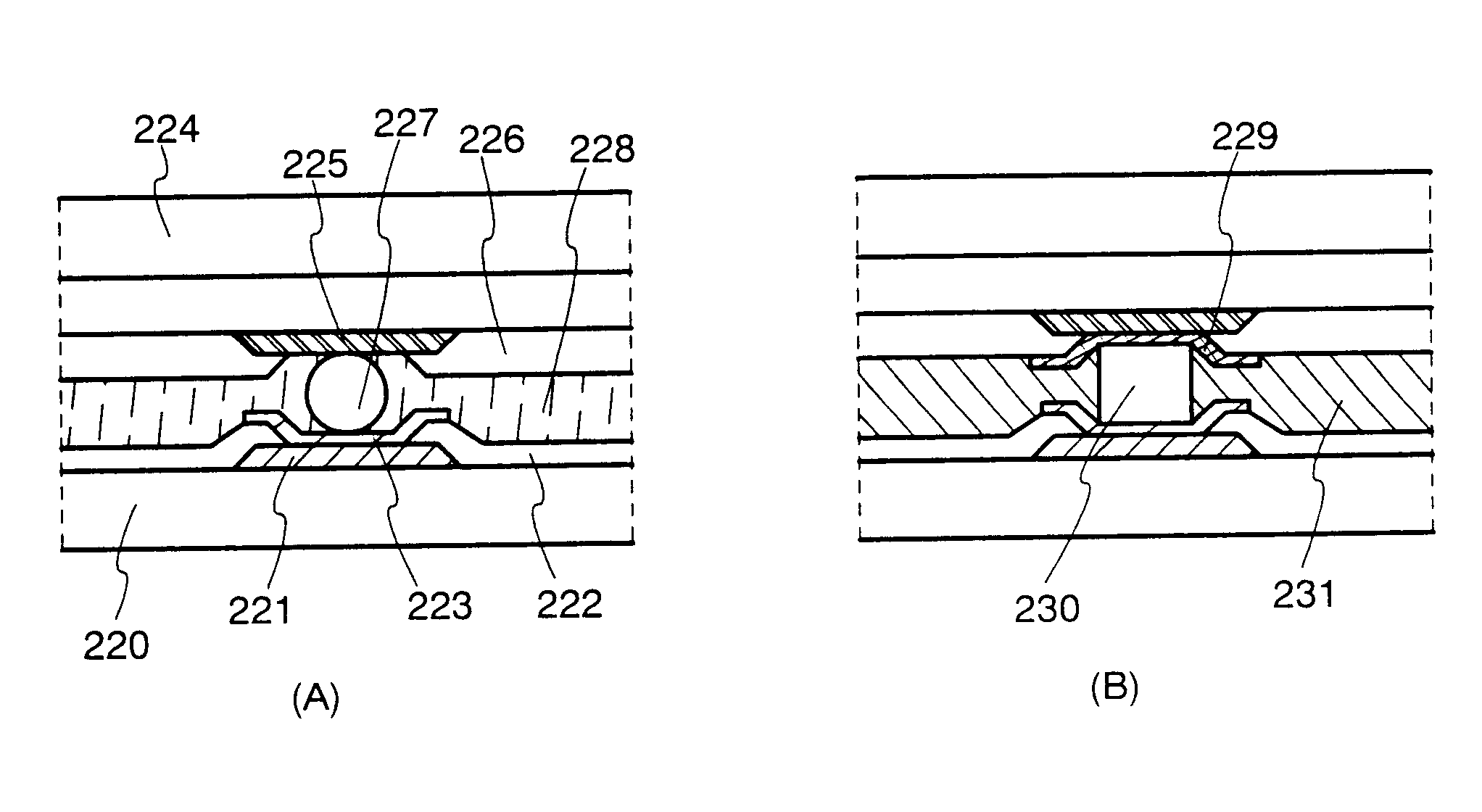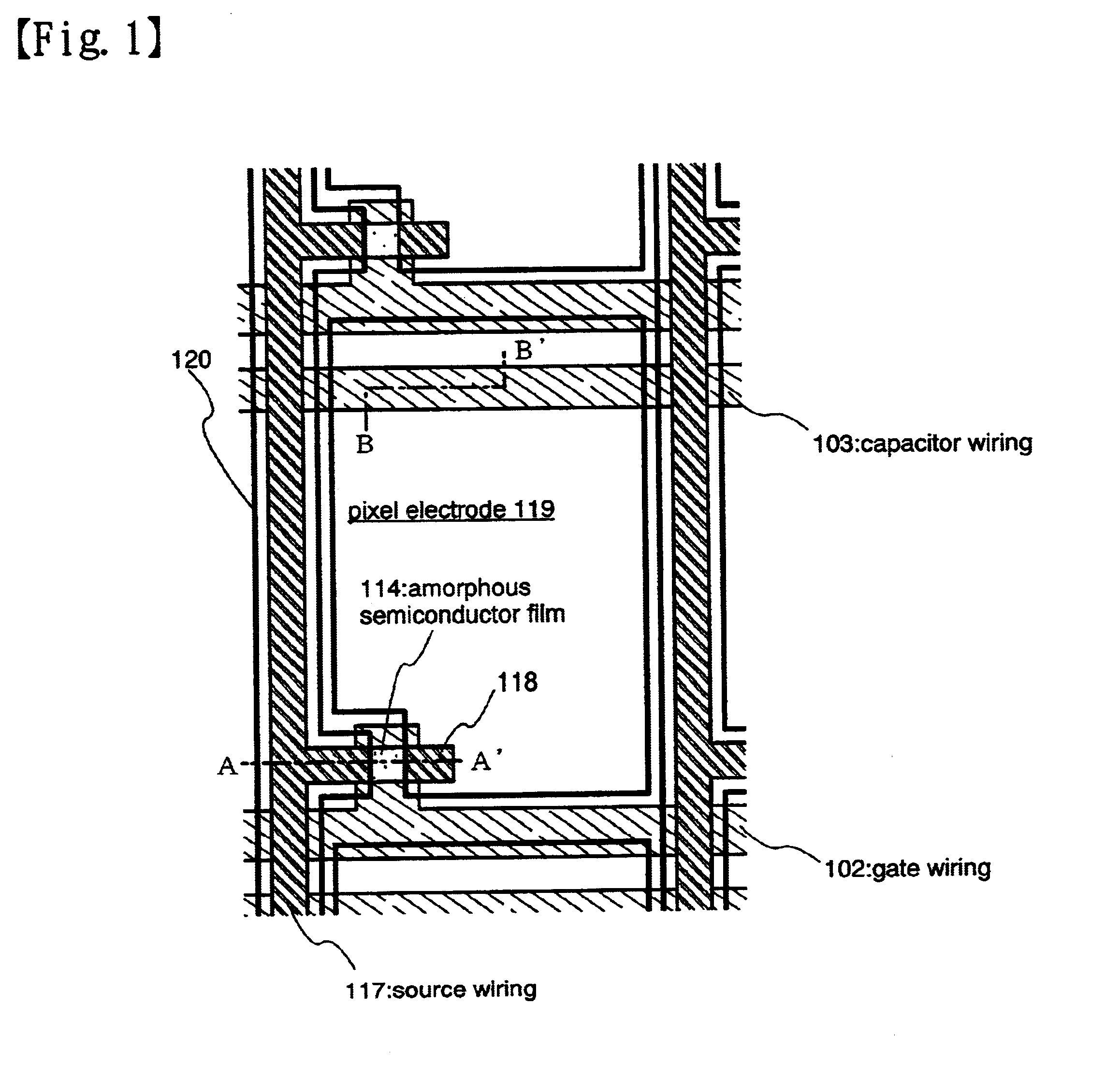Semiconductor device having stick drivers and a method of manufacturing the same
a technology of semiconductor devices and drivers, which is applied in the direction of semiconductor devices, instruments, optics, etc., can solve the problems of static electricity generation, limit in the reduction of manufacturing costs, and complicated work related to manufacturing
- Summary
- Abstract
- Description
- Claims
- Application Information
AI Technical Summary
Benefits of technology
Problems solved by technology
Method used
Image
Examples
embodiment 1
Embodiment 1 shows a method of manufacturing a liquid crystal display device, and a detailed explanation of a method of forming a TFT of a pixel portion on a substrate by a reverse stagger type TFT, and manufacturing a storage capacitor connected to the TFT, is made using FIGS. 1 to 5, in accordance with the processes used. Further, a manufacturing process for a terminal portion, formed in an edge portion of the substrate, and for electrically connecting to wirings of circuits formed on other substrates, is shown at the same time in the same figures.
In FIG. 2(A), a glass substrate, such as a barium borosilicate glass substrate or aluminum borosilicate glass substrate, typically Coming Corp. #7059 or #1737, is used as a substrate 100. In addition, a substrate such as a quartz substrate or a plastic substrate can also be used.
After forming a conductive layer over the entire surface of the substrate 100, a photolithography process using a first photomask is performed, and etching proce...
embodiment 2
In Embodiment 2, an example of forming a protecting film on the pixel TFT manufactured in Embodiment 1 is shown in FIG. 12. Note that Embodiment 2 is identical to Embodiment 1 through the state of FIG. 3(B), and therefore only points of difference are explained. Further, the same symbols are used for locations corresponding to those in FIG. 3(B).
After first forming through the state of FIG. 3(B) in accordance with Embodiment 1, a thin inorganic insulating film is formed on the entire surface. An inorganic insulating film such as a silicon oxide film, a silicon nitride film, a silicon nitride oxide film, or a tantalum oxide film is used as the thin inorganic insulating film, and a single layer or a lamination structure made from these materials may be formed.
A photolithography process is performed next using a fourth photomask, forming a resist mask, and unnecessary portions are removed by etching, forming an insulating film 402 in the pixel TFT portion, and an inorganic insulating f...
embodiment 3
In Embodiment 1 an example centering on forming an insulating film, a first amorphous semiconductor film, a single conductivity type second amorphous semiconductor film, and a first conductive film by sputtering, but Embodiment 3 shows an example of using plasma CVD to form the films. Specifically, the insulating film, the first amorphous semiconductor film, and the single conductivity type second semiconductor film are formed by plasma CVD.
A silicon nitride oxide film is used as the insulating film in Embodiment 3, and is formed with a 150 nm thickness by plasma CVD. At this time, the power source frequency in the plasma CVD device is from 13 to 70 MHz, preferably between 27 and 60 MHz. In particular, by using a power source frequency of 27 to 60 MHz, a dense insulating film can be formed, and as a gate insulating film, the voltage resistance can be increased. Further, a silicon nitride oxide film manufactured by adding SiH.sub.4, NH.sub.3, and N.sub.2 O has a relaxed stress in the...
PUM
| Property | Measurement | Unit |
|---|---|---|
| size | aaaaa | aaaaa |
| length | aaaaa | aaaaa |
| length | aaaaa | aaaaa |
Abstract
Description
Claims
Application Information
 Login to View More
Login to View More - R&D
- Intellectual Property
- Life Sciences
- Materials
- Tech Scout
- Unparalleled Data Quality
- Higher Quality Content
- 60% Fewer Hallucinations
Browse by: Latest US Patents, China's latest patents, Technical Efficacy Thesaurus, Application Domain, Technology Topic, Popular Technical Reports.
© 2025 PatSnap. All rights reserved.Legal|Privacy policy|Modern Slavery Act Transparency Statement|Sitemap|About US| Contact US: help@patsnap.com



